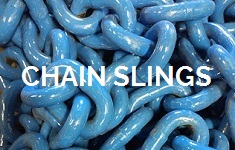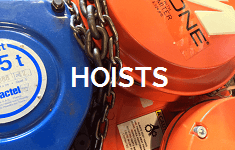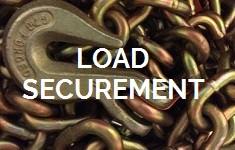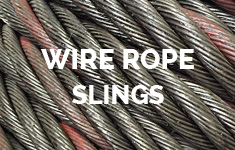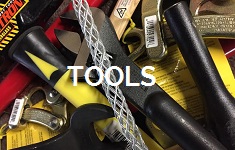How It’s Made
Tway Lifting Products has manufactured lifting and rigging equipment for over 70 years. We specialize in wire rope slings, chain slings and custom engineered lifting assemblies used for general material handling and the safe placement of goods in many industries.
Wire rope slings serve as a vital tool when lifting heavy objects such as rough castings, heavy, hot or irregular shaped metal or stone parts.
In many of the industries we do business with, long term durability and corrosion resistance is particularly significant. Industries like the aerospace, automotive and the pharmaceutical industry require only the best. Our welded alloy steel and stainless chain slings are used to provide the best possible securement and protection.
Synthetic web and round slings are most often considered for use where load surface protection is imperative. Several applications include the movement of lumber, pipe, finished masonry and machined aerospace components.
Here at Tway, we are focused on the satisfaction of our customers. In many circumstances, additional fittings are necessary to attach a sling to a load. We carry a variety of shackles, hooks and lifting eyes suitable for the proper connection of our products.
A spreader bar is a device that assists with lifting heavy objects or loads. It is used adjacent to lifting machines such as cranes, and their role is to spread out the weight better to ensure a safe and effective carry.
The spreader bar for cranes works by redistributing the forces that influence the lifts, making for a more balanced load carrying. Spreader bars are positioned below the hook of the crane. They are attached to the hook with slings, cables, or chains which connect to several attachment points.
The crane can carry various loads with a spreader bar, with different dimensions and weights. The type of crane and the design of the spreader bar must be adequate for the object that needs lifting; otherwise, it can lead to malfunction or damage to the load.
Spreader Bar for Cranes
Cranes are lifting machines that play an integral role in many sectors. Their function is to lift and carry heavy loads. They’re used in many industries like construction, oil and gas, shipping, mining, manufacturing, etc.
A spreader bar works as an extension to the crane, providing a better redistribution of the weight, which helps to lift and carry the objects more easily. It is advantageous in carrying irregularly shaped objects as multiple attachment points provide better stability.
Having multiple attachment points helps transform the physics of the lifting action. It creates a compressive force to act on the spreader bar and a tensile force to influence the slings, ropes, or chains carrying it.
To ensure a safe and effective lift, the spreader bar’s design has to fit the nature of the task, i.e., the load’s weight, dimensions, and shape. A longer and thinner load, like pipes or steel beams, requires thinner bars with more attachment points for better balance. A wide and heavy load will require a wider spreader bar.
Types of Spreader Bars
There are different types of spreader bars, and the classification is down to their design, application, and purpose. They are all for below-the-hook use adjacent to a crane.
Fixed spreader bars
Fixed spreader bars’ dimensions aren’t changeable. It’s best to use them when there’s consistency with the load’s dimensions and weight. They are more stable and effective because they are often specifically designed to handle specific objects.
If there aren’t different types of loads as part of the lifting task, then using fixed spreader bars is the cheaper and better choice.
Adjustable spreader bars
As the name suggests, adjustable spreader bars allow for adaptation to various dimensions of the loads or objects. The adaptability of the spreader bars can be in length through a telescopic system or the number of attachment points.
They’re less stable than fixed spreader bars but necessary for lifting loads with varying dimensions. The telescopic adjustment system means the bar has an extension moving in and out of itself with a pin holding it in place.
Modular spreader bars
These spreader bars can be assembled in different configurations to fit different types of loads or objects. The advantage is that they are easy to transport, and in the case of malfunction, the parts are repaired or replaced in isolation which shortens the time the device spends out of order.
Assembly and disassembly of modular spreader bars can be done on-site, which is a very convenient feature. However, the lightweight nature of the material they’re made of limits the array of tasks they’re suitable for.
Basket spreader bars
They’re called basket-style spreader bars because they come with four or more attachment points, carrying the spreader bar like a basket. They are suitable for long and thin objects like pipes or steel beams.
Types of Cranes
There are different types of cranes to fit different types of tasks. This categorization is not to determine the lifting capacity but rather their type and function.
Mobile cranes
To put it simply, they are cranes that can be moved easily. They are usually adjacent to a vehicle like a truck, or they can be on rails or caterpillar tracks. They are mostly used in construction and various other industries.
Spreader bars on a mobile crane are usually made of lighter materials like aluminium, and ideally, they would be designed especially for this type of use. Mobility is a great feature for a crane, but in most cases, it limits the load’s size.
The crane is carried on top of the vehicle, and it extends in a telescopic way once it arrives at the right location. Once the task is fulfilled, it reverts back.
The capacity of the mobile crane depends largely on how much it has to extend to reach the load. The less it’s extended – the higher the capacity for lifting, and vice versa.
Crawler cranes
Crawler cranes are very prevalent because they offer stability and safety along with their mobility feature. They have crawler tracks, and their capacity ranges from 40 to 4000 long tons depending on their size.
In general, crawlers provide more stability while lifting than wheels. Spreader bars improve the stability and balance of the crawler cranes while carrying heavy loads or objects.
Floating cranes
These types of cranes are used in the construction of bridges and ports. They are sometimes used for pulling out sunken ships.
Rough terrain cranes
They are typically used for projects on uneven ground. They are wheeled, single-engine machines with a telescopic mechanism.
Fixed cranes
Fixed cranes are assembled on the spot, and they are not movable. They require a concrete foundation because of their enormous size. For the purpose of this article, we will primarily discuss tower cranes, but other fixed cranes include ring cranes, hammerhead cranes, level luffing cranes, gantry cranes, etc.
Tower cranes
Tower cranes are mostly used in the construction of large buildings or other objects to move materials and equipment from one place to another. Tower cranes are tall and have a deep concrete foundation for stability, usually built one month before the crane is installed.
Near the top of the mast is a horizontal object called “an arm” or “a jib,” which is controlled by the crane operator sitting in a cabin where the vertical and horizontal extensions of the crane connect. A trolley that is moved forward or backward connects to the jib, and the hook is connected to the trolley.
The hook moves up and down and attaches directly to the load or to a device that helps balance the weight, like a lifting beam or a spreader bar. The spreader bar is attached to the hook through chains or cables that connect to the spreader bar’s attachment points.
The assembly of a tower crane usually requires mobile cranes.
Spreader Bar Rental
In our company, we manufacture, sell, and rent lifting equipment of the highest quality, and we specialize in shackle rental, hoist, spreader bar rental, etc.
So, if you need a spreader bar rental service, feel free to reach us! Moreover, we can help you find out more about various solutions for the tasks ahead of you and how we can help complete them.
https://www.youtube.com/watch?v=bUUBHg7bpO4
Summary
Different types of cranes are designed to complete different tasks, but the main categorization is mobile and fixed. Mobile cranes move by crawlers, wheels, or on water. Fixed cranes are assembled on-site where the construction or other action is happening.
Fixed cranes are called tower cranes because they are tall, and their most common purpose is to make towers or buildings. The use of a spreader bar is prevalent for most types of cranes because it is a device that helps with having a well-distributed weight when performing the lifting.
There are various types of spreader bar for cranes, and choosing the right one depends on the object’s weight and dimensions. Fixed spreader bars are the strongest, but their dimensions cannot be altered; adjustable bars are adaptable to various dimensions but aren’t as strong and durable.
The movement of heavy objects requires machinery that is specialized in performing such actions. The lifting industry is crucial for sectors like construction, mining, transport, oil and gas, entertainment, etc.
Lifting equipment is designed to effectively move objects or loads while minimizing the risk of damage to the goods and injury to workers. Common types of machinery include cranes, hoists, and forklifts, all of which use mechanisms specifically adapted to their work type.
The lifting industry is highly regulated to ensure workplace safety, which is why many different types of spreader bars or spreader beams are used for executing this particular action.
Types of Spreader Bars
A spreader bar is a device used as an extension to cranes that allows for an equal distribution of the load over multiple lifting points. It has a straight beam, usually with two attachment points for lifting equipment, like chains or slings.
Not using a spreader bar would mean lifting heavy loads with a single attachment point which is dangerously unstable. Heavy objects can cause the load to shift during the lifting process and, in the worst case, fall down, resulting in damages and exposing workers to potential dangers.
Therefore, there are various types of spreader bars designed to fit different purposes, i.e., lift different types of load. The categorization is mostly determined by the adaptability of the device.
Regardless of the type, all spreader bars must comply with OSHA and ASME B30.20 regulations. The former is about safety workplace standards in the USA, which covers all lifting operations in general. The latter is more specific and covers all below-the-hook lifting devices, such as spreader bars.
Here are some types of spreader bars used in the lifting industry:
- Fixed spreader bars
- Adjustable spreader bars
- Modular spreader bars
- Basket-style spreader bars
Fixed Spreader Bars
Fixed spreader bars are useful when the weight and the dimensions of the load don’t change during the entire lifting operation because, as the name suggests, they are fixed in regard to length and size.
Fixed spreader bars offer more stability than adjustable ones because they are specifically designed for certain load dimensions and weights.
If the dimensions and weight of the load don’t change, then having fixed spreader bars are more cost-effective, durable, and easier to use than adjustable spreader bars.
Adjustable Spreader Bars
These types of spreader bars can be adjusted in length in order to be used for various applications. The way to adjust the length is by manipulating the position of the attachment points at each end to accommodate different load dimensions.
The adjustable spreader bars are not as stable as the fixed ones, but the advantage they offer is that they can be used to fit multiple dimensions of objects or loads.
The design of the adjustable spreader bar is such that the length of the spreader bar is adjusted in a telescopic way, i.e., the bar has an extension moving within itself.
Adjusting the length of the bar is fairly easy and modifiable. Once the dimensions are determined, the bar needs to be extended or reduced to the desired length, which is where the pin or pins will be installed.
Modular Spreader Bars
These spreader bars allow for increased versatility because they are fabricated in pieces and can be assembled in different configurations to fit different load dimensions.
They consist of many replaceable sections that can be combined in a number of ways to create the optimal configuration needed for a specific load. The advantage of using modular spreader bars is that their components are lightweight and can be easily delivered and assembled on-site.
Also, in the case of malfunction, the components are repaired in isolation instead of servicing the whole device.
Basket-style Spreader Bars
Basket-style spreader bars have four attachment points with the purpose of distributing the weight even more evenly. The attachment points form a basket-type form hence the name of the configuration. They are sometimes referred to as cradle spreader bars.
They are most commonly used with steel beams, pipes, and other shapes. Some basket-style spreader bars are adjustable, and others are fixed with specific dimensions.
Spreader Bar Rental
Now that you know about various types of spreader bars, you can visit us at Tway Lifting and check out our spreader bar rental service.
You are one phone call away from acquiring our services and renting our equipment. Our trained personnel will help you determine your needs and come up with solution ideas for your problems.
Frequently Asked Questions
How to choose the right spreader bar for a specific task?
Choosing the right spreader bar requires assessing the load’s weight, shape, and size. Then, it needs to be paired with the equipment that has the configurations to safely and effectively handle such a load.
What is WLL?
WLL, or workload load limit, is the maximum weight a specific spreader bar is designed to lift. To calculate the WLL, factors like the material of the spreader bar, its design, and its construction are considered, as well as the number of attachment points.
What safety precautions should be taken when lifting with a spreader bar?
There are many safety precautions, but first and foremost, it is vital to use an adequate spreader bar for the specific load.
Using the correct type and size of sling or other lifting device and not exceeding the WLL. The load should be well-balanced and stable, etc.
How do spreader bars distribute the weight more evenly?
Spreader bars have multiple attachment points. When you lift a load with a single attachment point, the weight is concentrated on that point, putting stress on the machine. This is based on the Principle of Moments.
Summary
Spreader bars are used to lift objects or loads with better weight distribution. There are fixed, adjustable spreader bars, modular, and basket types of spreader bars that are distinguished by their design and purpose.
They are commonly used in construction, mining, manufacturing, shipping, and many other industries. Their popularity is down to them minimizing the risk of damage or injury to workers.
Watch as one of our specially trained chain sling fabricators works on a mechanical Grade 80 SGG chain sling.
-Narration by Dave Dugan
Indianapolis Liederkranz Bell Choir preforms a special arrangement of Carol of the Bells by Loesje Chandler, with some VERY unique instruments done in Tway Lifting Products style.
www.twaylifting.com
www.indyliederkranz.org
In this video we show you how we used Crosby WireLock and Crosby Spelter Sockets on 1 1/8″ Galvanized Cable to help create the Shade Sail Structure for the Eiteljorg Museum of American Indians and Western Art
The project was designed by architect Jonathan Hess of Browning Day Mullins Dierdorf, who also designed the main building of the museum.
The Shade Sail Structure was installed by F.A. Wilhelm Construction Company, Inc. of Indianapolis, IN.
-Narration by Dave Dugan




